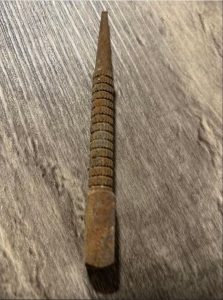Sometimes, you stumble upon a tool so simple yet essential that it almost escapes notice. It’s one of those items that might make you pause, scratch your head, and wonder, “What is this thing actually used for?” If you’ve ever held a small metal rod with a pointed tip and wondered what its purpose could be, you might be looking at one of the most underrated tools in construction history—the nail punch. And if you’re curious to understand how such a basic-looking object plays a big role in the world of carpentry and craftsmanship, you’re in the right place.

The nail punch, also known as a nail set, may not have the same flashiness as electric drills or laser levels, but its functionality has stood the test of time. In fact, the concept of this humble tool goes all the way back to ancient civilizations. Even before modern woodworking, early humans used similar tools—often simple chisels or stones—to drive nails and fasteners beneath the surface of wooden structures or decorative pieces. Some historians even believe that primitive variations of the nail punch were among the first tools used by our ancestors to work with wood and stone, and even to aid in crafting basic clothing from animal hides. Despite their primitive design, these tools offered versatility and control that made them invaluable to early craftsmen.
Fast forward to modern times, and the nail punch remains a staple in toolboxes around the world. It’s a small handheld instrument that serves a single but crucial purpose: driving nails slightly below the surface of a material—usually wood—to create a smooth and even finish. This tool typically has a narrow cylindrical body, a pointed end that lines up with the nail head, and a flat end that you strike with a hammer. The idea is to avoid hitting the wood directly with a hammer, which can cause dents, chips, or uneven surfaces. By using a nail punch, you can ensure that the nail sits below the wood’s surface, allowing you to cover it with filler or putty for a polished and seamless look.
According to experts, after driving the nail down using the punch, the small hole that remains can be filled with putty. This not only creates a cleaner appearance but also adds a layer of protection against moisture and rust. It’s this attention to detail that separates amateur work from professional-quality results, especially in visible finish carpentry like baseboards, trim, and cabinetry.
During the Industrial Revolution, the production of nails became faster and more uniform. With that came the need for tools that could offer the same level of consistency and precision. The nail punch quickly became a must-have tool, allowing workers to drive nails to uniform depths and then cover them to prevent rust or visible imperfections. Over time, the tool was refined and adapted to meet the demands of more complex woodworking projects. Its simple design allowed it to evolve without losing its original purpose, which is why it continues to hold value in both casual and professional settings.
Today’s nail punches have come a long way in terms of materials and comfort. They’re typically made from hardened steel or titanium to withstand constant impact, and many models now come with cushioned grips or ergonomic handles for better control and less hand fatigue. Some modern versions are even spring-loaded or automatic, allowing users to apply the necessary force without needing a hammer. These innovations have made the tool more accessible to a wider range of users, from weekend DIYers to full-time contractors.
Nail punches are also available in various sizes to match the diameter of different nails. This is important because using the wrong size can either damage the nail head or make it difficult to recess the nail properly. Many punch sets include size labels, often etched into the side with laser precision, so users can quickly identify and select the right tool. These seemingly small details can make a big difference, especially when working on delicate trim or antique restoration projects where precision is key.
Aside from aesthetics, using a nail punch offers practical advantages. For example, recessing a nail prevents its head from being exposed to air and moisture, reducing the risk of rust. It also protects surfaces from being scratched or marred by hammer strikes. These small preventative measures can significantly extend the life and appearance of wooden structures, particularly in areas exposed to the elements.
In a time when power tools dominate workshops, the nail punch stands out as a reminder that sometimes, simple is better. There’s something satisfying about the control and finesse that comes with using a manual tool like this. It’s not just about sinking a nail—it’s about taking pride in craftsmanship. That’s why the nail punch still matters. Whether you’re building furniture, repairing an old staircase, or installing crown molding, this tool helps deliver clean, professional results every time.
For those who appreciate the old-school approach to construction, the nail punch holds a kind of nostalgic charm. It reflects a time when tools were built to last, and quality came from attention to detail, not just speed. And for new generations learning the trade, mastering the nail punch can be a rite of passage—proof that you understand the basics before jumping into more complex equipment.
So, if you’ve got one of these modest tools tucked away in your toolbox, take another look at it. That small, unassuming rod has been helping builders, carpenters, and craftsmen for centuries. It’s proof that even the most ordinary-looking items can play an extraordinary role when it comes to building things that last.





